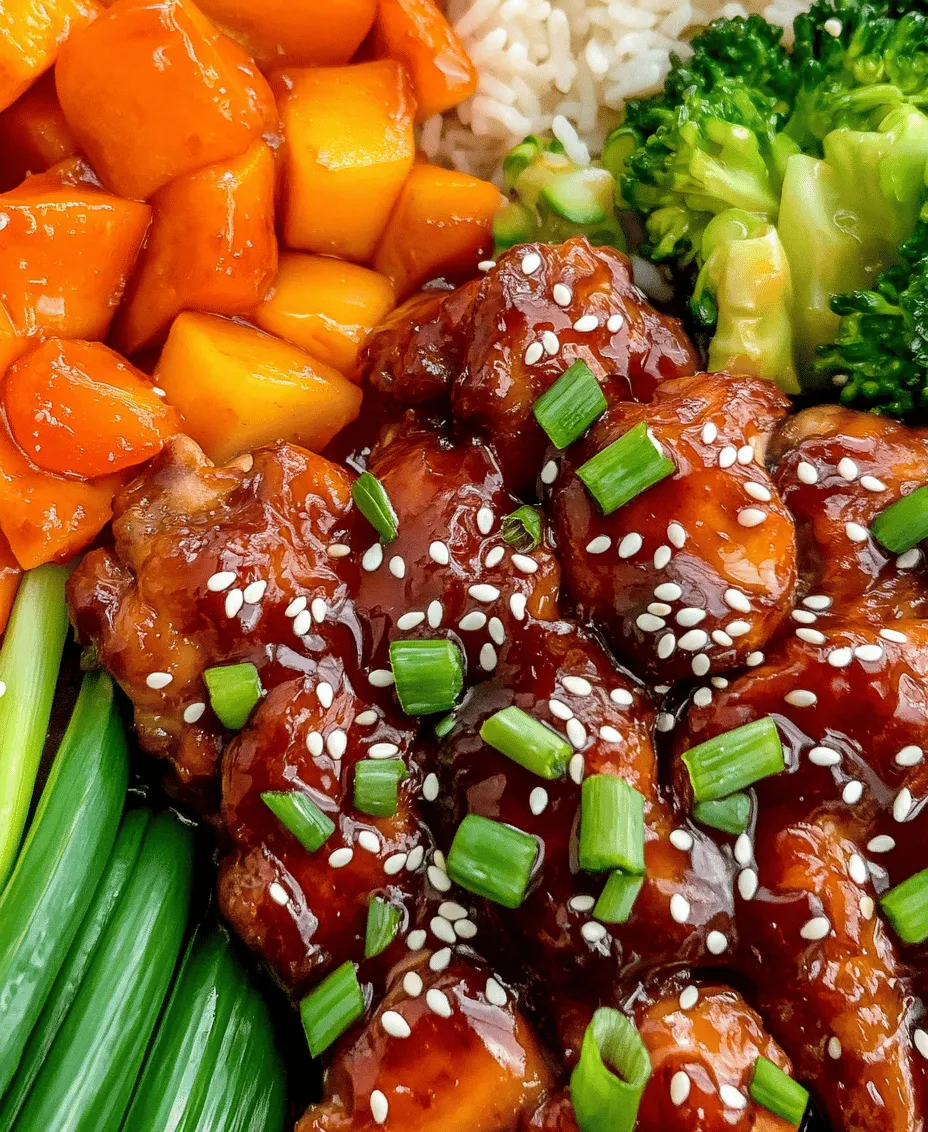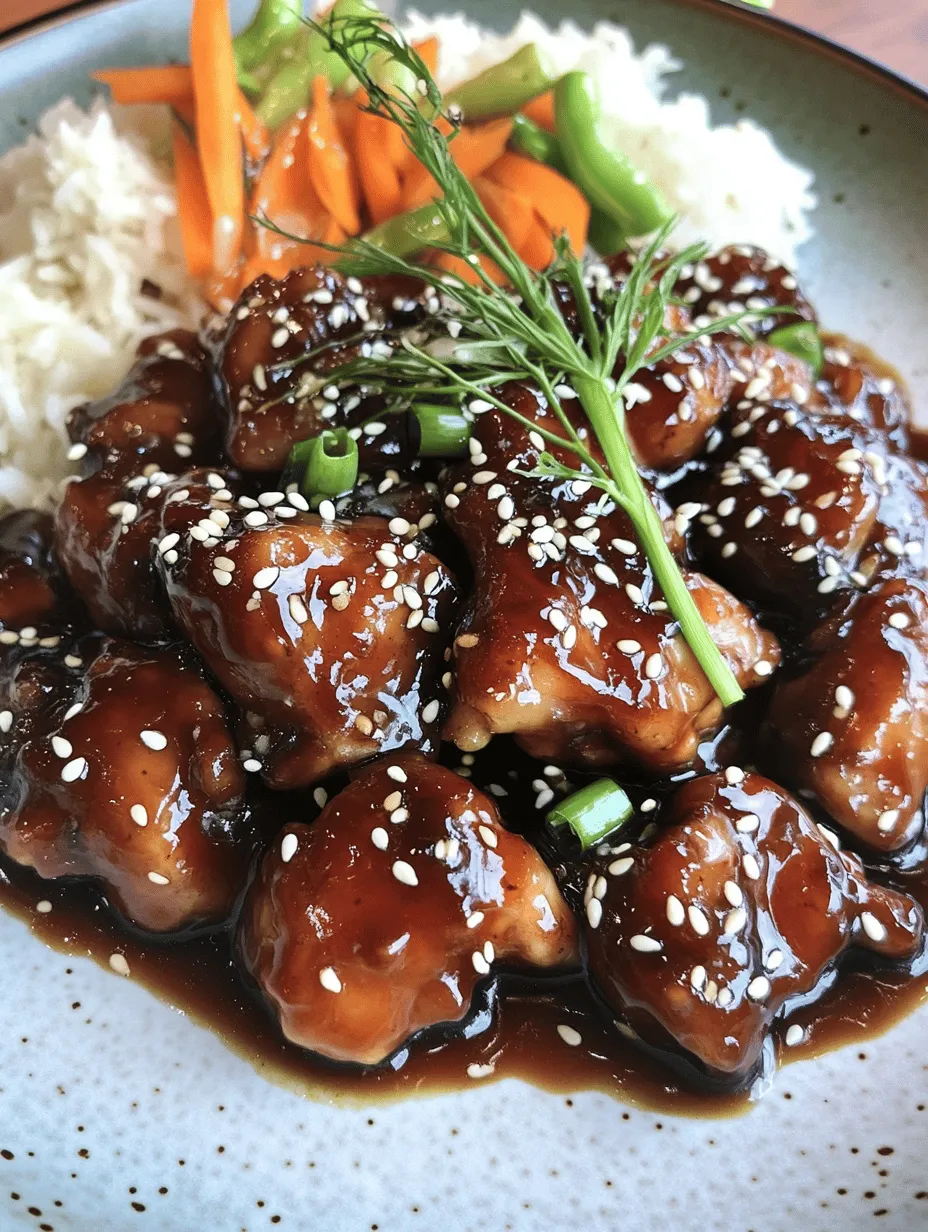Introduction
Aloha Shoyu Chicken is more than just a dish; it’s a celebration of Hawaiian culture and culinary traditions that brings the essence of the islands right to your dinner table. This delectable recipe features tender, marinated chicken thighs that soak up a sweet and savory sauce, making it a perfect choice for family dinners or special occasions. Whether you’re hosting a luau, enjoying a casual weeknight meal, or looking to impress guests, Aloha Shoyu Chicken promises to deliver vibrant flavors that evoke the warmth and spirit of Hawaii.
One of the hallmarks of this dish is its reliance on fresh, high-quality ingredients. Each component plays a vital role in creating the rich tapestry of flavors that defines Aloha Shoyu Chicken. From the umami-packed soy sauce to the brightness of fresh garlic and ginger, this dish showcases the importance of using the best ingredients available to enhance the overall taste experience. As you embark on this culinary journey, you’ll discover how simple yet impactful these ingredients can be in crafting a meal that feels both comforting and exotic.
Understanding the Ingredients
To craft the perfect Aloha Shoyu Chicken, it’s essential to understand the role of each ingredient and how they contribute to the finished dish. Let’s take a closer look at the key components that make this recipe a standout.
Chicken Thighs: Why Bone-In and Skin-On Are Preferred
When it comes to selecting chicken for Aloha Shoyu Chicken, bone-in, skin-on chicken thighs are the best choice. The bone helps to retain moisture during cooking, ensuring that the meat remains juicy and tender. The skin, when seared, develops a wonderfully crispy texture that contrasts beautifully with the tender meat beneath. This combination offers a satisfying bite that elevates the dish’s overall appeal. Additionally, chicken thighs are known for their richer flavor compared to chicken breasts, making them an ideal canvas for the marinade.
Soy Sauce: The Backbone of the Marinade
Soy sauce is the foundational ingredient in this recipe, providing the essential umami flavor that defines many Asian dishes. In Aloha Shoyu Chicken, soy sauce not only adds saltiness but also helps to tenderize the chicken, breaking down proteins and allowing the flavors to penetrate deeply. When choosing soy sauce, opt for a quality brand that uses traditional brewing methods, as this will enhance the dish’s authenticity and taste.
Brown Sugar: Balancing the Saltiness with Sweetness
Brown sugar brings a delightful sweetness that balances the saltiness of the soy sauce. This interplay of flavors is crucial for achieving the signature taste of Aloha Shoyu Chicken. The molasses content in brown sugar also adds depth, enriching the marinade and creating a beautifully caramelized exterior when the chicken is cooked. For those looking for a healthier alternative, coconut sugar can be used as a substitute, providing a similar sweetness with a lower glycemic index.
Rice Vinegar: Adding Acidity to Brighten Flavors
Rice vinegar is another critical component of the marinade, contributing a subtle acidity that brightens the overall flavor profile. This acidity helps to cut through the richness of the chicken and balances the sweetness of the brown sugar. It’s important to use rice vinegar, as its mild flavor complements the dish without overpowering it. If rice vinegar is unavailable, you can substitute it with apple cider vinegar, but be mindful of the stronger taste.
Garlic and Ginger: Essential Aromatics for Depth
Garlic and ginger are indispensable aromatics in Aloha Shoyu Chicken, adding layers of flavor that enhance the dish. Garlic provides a savory depth, while ginger offers a zesty warmth that pairs beautifully with the other ingredients. Freshly minced garlic and ginger are preferred for their potency, but if you’re in a pinch, you can use powdered forms—though fresh is always best for maximum flavor.
Green Onions: For Freshness and Garnish
Green onions, also known as scallions, serve a dual purpose in this recipe: they add a fresh, crisp element to the dish and act as a colorful garnish. Sliced thinly and sprinkled on top just before serving, they provide a burst of color and a mild onion flavor that complements the rich marinade. Green onions are easy to find and can elevate the presentation of your Aloha Shoyu Chicken.
Sesame Oil: Adding a Nutty Flavor
A drizzle of sesame oil adds a nutty richness that rounds out the flavors of the marinade. This oil is typically used sparingly due to its strong flavor, but it plays a crucial role in enhancing the overall taste. Look for toasted sesame oil for the most intense flavor, and be sure to add it towards the end of the marinade process to preserve its aromatic qualities.
Spices: Black Pepper and Optional Red Pepper Flakes for Heat
Finally, black pepper adds a gentle heat and enhances the dish’s complexity, while red pepper flakes can be added for those who enjoy a bit of spice. The level of heat is adjustable based on personal preference; a pinch of red pepper flakes can transform the dish, making it more dynamic without overpowering the other flavors.
Preparing the Aloha Shoyu Chicken
With a solid understanding of the ingredients, it’s time to dive into the preparation of Aloha Shoyu Chicken. The key to this dish lies in the marinating process, which allows the flavors to meld and infuse the chicken thoroughly.
Importance of Marinating for Flavor Infusion
Marinating is a crucial step that elevates Aloha Shoyu Chicken from a simple meal to a flavorful masterpiece. The marinade not only adds a depth of flavor but also tenderizes the chicken, ensuring that each bite is juicy and succulent. Ideally, the chicken should be marinated for a minimum of one hour, but for optimal flavor, marinating overnight is recommended. This extended time allows the soy sauce, brown sugar, and aromatics to penetrate the meat more deeply, resulting in a richer taste.
Detailed Explanation of the Marinating Process
To prepare the marinade, begin by combining the soy sauce, brown sugar, rice vinegar, minced garlic, and ginger in a bowl. Whisk these ingredients together until the sugar is dissolved and the mixture is well-combined. Next, add the sesame oil, black pepper, and, if desired, red pepper flakes for heat. Once your marinade is ready, place the chicken thighs in a large resealable plastic bag or a shallow dish and pour the marinade over the top, ensuring that each piece is well-coated.
Seal the bag or cover the dish with plastic wrap, then refrigerate. If using a bag, occasionally massage the chicken to help the marinade permeate the meat. The longer the chicken marinates, the more flavorful it will become, so plan accordingly.
Recommended Marination Times for Optimal Flavor
As mentioned, for the best results, aim to marinate the chicken for at least one hour. However, marinating for four hours or even overnight is ideal, especially if you have the time. This allows the flavors to develop fully, resulting in tender, flavorful chicken that shines when cooked.
Searing the Chicken: Technique and Tips
Once the chicken has marinated, it’s time to cook! Searing the chicken is a crucial step that locks in moisture and creates a beautiful, caramelized crust. Begin by heating a large skillet or cast-iron pan over medium-high heat. Add a splash of oil (such as vegetable or canola oil) to prevent sticking.
Remove the chicken thighs from the marinade, allowing any excess liquid to drip off. Carefully place the chicken skin-side down in the hot pan. Avoid overcrowding the skillet; if necessary, cook in batches to ensure even cooking and browning. Allow the chicken to sear undisturbed for about 5-7 minutes, or until the skin is golden brown and crispy.
Achieving Crispy Skin and Locking in Juices
The key to achieving crispy skin lies in not moving the chicken around too much during the searing process. Letting it cook undisturbed allows the skin to render its fat, creating that desirable crunch. After the skin has developed a nice golden color, use tongs to flip the chicken over and cook for an additional 5 minutes on the other side.
After searing, the chicken will be partially cooked but not completely done. This method ensures that the skin remains crispy while the meat stays juicy.
Simmering in Marinade: Creating a Flavorful Sauce
After searing the chicken, it’s time to introduce the marinade back into the pan. Pour in the leftover marinade, scraping the bottom of the skillet to release any browned bits—this adds even more flavor to the sauce. Bring the mixture to a gentle simmer, cover the pan, and allow the chicken to cook through for about 20-25 minutes. This simmering process allows the chicken to absorb even more of the marinade’s flavors while creating a rich, savory sauce.
As the chicken cooks, you’ll notice the aroma filling your kitchen, inviting everyone to gather around the table. The sauce will thicken slightly as the sugars in the marinade caramelize, creating a glossy finish that clings beautifully to the chicken.
With these detailed preparation steps, you’re well on your way to creating a mouthwatering Aloha Shoyu Chicken that will impress family and friends alike. Enjoy the delightful flavors of Hawaii as you savor each bite of this delicious dish, bringing a taste of the islands to your home.

Simmering Process and Its Significance
Simmering is a crucial step in crafting the perfect Aloha Shoyu Chicken. When you simmer the chicken in the marinade, you allow the flavors to meld beautifully while ensuring the meat remains tender and juicy. The gentle heat breaks down the proteins in the chicken, making it more succulent and absorbing the savory, sweet, and umami notes from the shoyu (soy sauce), pineapple juice, garlic, and ginger. This process not only enhances the flavor but also helps to create a sauce that is rich and layered.
To effectively simmer your chicken, bring your marinated chicken and sauce to a gentle boil in a large skillet over medium-high heat. Once boiling, reduce the heat to low and cover the skillet. Allow the chicken to simmer for about 30-40 minutes, turning occasionally to ensure even cooking. This method allows the chicken to soak in all the flavors while cooking through without drying out, resulting in a dish that’s moist and bursting with taste.
Thickening the Sauce
Thickening the sauce in your Aloha Shoyu Chicken recipe is essential for achieving a rich and satisfying dish. A thicker sauce clings beautifully to the chicken, enhancing each bite and making the meal more enjoyable. The glossy, thickened sauce also adds an appealing visual element to your plate.
Step-by-Step Guide on Using Cornstarch for Sauce Consistency
1. Prepare the Cornstarch Slurry: In a small bowl, combine 1 tablespoon of cornstarch with 2 tablespoons of cold water. Stir until smooth. This mixture is known as a cornstarch slurry, and it will help thicken your sauce without creating lumps.
2. Add the Slurry to the Sauce: When your chicken is fully cooked and the sauce has reduced slightly, gently stir in the cornstarch slurry. Allow the mixture to come back to a gentle simmer.
3. Cook Until Thickened: Stir continuously for about 1-2 minutes, or until the sauce thickens to your desired consistency. It should coat the back of a spoon nicely. If you prefer an even thicker sauce, you can add more cornstarch slurry in the same ratio until you achieve the desired texture.
Tips for Achieving the Perfect Sauce Texture
– Avoid Overheating: When thickening the sauce, ensure that you do not boil it vigorously after adding the cornstarch slurry, as this can break down the thickening agent and lead to a thinner sauce.
– Adjust Seasoning: After thickening the sauce, taste and adjust the seasoning if necessary. You may want to add a pinch of salt or a splash of additional soy sauce to enhance the flavor.
– Use Fresh Ingredients: Fresh garlic and ginger not only contribute to the flavor but also add a layer of depth to your sauce. Using fresh, high-quality ingredients will yield the best results.
Serving Suggestions
Plating your Aloha Shoyu Chicken beautifully can elevate your dining experience. Here are some tips for presenting your dish:
1. Choose the Right Plate: A large, flat plate allows for a beautiful presentation. Consider using a white plate to make the colors of the dish pop.
2. Arrange the Chicken: Place the chicken pieces in the center of the plate, spooning some of the thickened sauce over the top.
3. Add Side Dishes: Aloha Shoyu Chicken pairs wonderfully with steamed rice and sautéed or steamed vegetables. For a classic touch, serve it with jasmine or basmati rice, as these varieties complement the flavors of the dish beautifully.
4. Garnishing: To enhance visual appeal, sprinkle sesame seeds and finely chopped green onions over the chicken just before serving. This not only adds a pop of color but also provides a subtle crunch and freshness that balances the dish.
Ideal Side Dishes to Complement the Meal
To create a well-rounded meal, consider these ideal side dishes:
– Steamed Jasmine Rice: The fluffy texture and subtle flavor of jasmine rice absorb the delicious sauce, making it a perfect companion for the Aloha Shoyu Chicken.
– Stir-Fried Vegetables: A colorful mix of bell peppers, broccoli, and snap peas sautéed in a bit of garlic and sesame oil brings a crunchy contrast to the tender chicken.
– Pineapple Fried Rice: For a tropical twist, prepare pineapple fried rice. The sweetness of the pineapple complements the savory chicken and adds complexity to the meal.
Nutritional Information
Aloha Shoyu Chicken not only delights the palate but also offers a variety of nutritional benefits:
– Protein Source: Chicken is an excellent source of lean protein, essential for muscle repair and growth. It provides the body with energy and is vital for overall health.
– Garlic and Ginger Benefits: Garlic is known for its immune-boosting properties and is rich in antioxidants. Ginger has anti-inflammatory properties and can aid digestion, making both these ingredients excellent additions to your dish.
– Nutritional Profile: A serving of Aloha Shoyu Chicken typically contains around 300 calories, depending on the portion size and ingredients used. The combination of protein, healthy fats from sesame seeds, and vitamins from vegetables creates a balanced meal.
Cultural Significance of Aloha Shoyu Chicken
Aloha Shoyu Chicken is not merely a dish; it embodies the spirit of Hawaiian cuisine, which is a vibrant blend of influences from various cultures, including Asian, Polynesian, and American traditions. The use of shoyu—a Japanese term for soy sauce—highlights the Asian influence on Hawaiian cooking, while the incorporation of pineapple reflects the tropical bounty of the islands.
In Hawaiian culture, food plays a significant role in gatherings and celebrations. Aloha Shoyu Chicken is often served at luaus, family reunions, and potlucks, symbolizing hospitality and the joy of sharing meals with loved ones. Personal anecdotes or stories of enjoying Aloha Shoyu Chicken with friends and family can deepen your connection to this dish, making it a cherished part of your culinary repertoire.
Conclusion
In summary, Aloha Shoyu Chicken is a dish that brings together a harmonious blend of flavors, textures, and cultural significance. The simmering process ensures that the chicken absorbs the sweet and savory notes of the marinade, while thickening the sauce enhances its richness. With thoughtful plating and complementary side dishes, this meal becomes a feast for both the eyes and the taste buds.
As you embark on your culinary journey to create Aloha Shoyu Chicken, remember that cooking is not just about following a recipe; it is about the experiences, memories, and connections forged through the act of sharing meals. Embrace the flavors, explore the techniques, and savor the joy of cooking. Gather your loved ones, serve this delightful dish, and create lasting memories around the table. Enjoy every moment as you bring this taste of Hawaii into your home.



